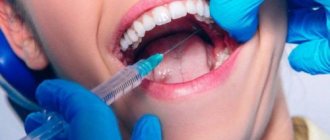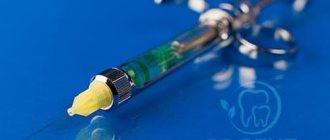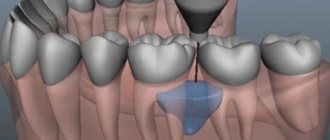For many years, dental treatment was accompanied by pain or discomfort. All this contributed to the development of a great fear of going to the dental office. People have become so afraid of doctors that they are ready to risk their health by testing dubious traditional methods on themselves just to avoid going to an appointment.
Pain and discomfort can be completely eliminated with the help of anesthesia; it is usually used when pain cannot be tolerated. But the injection or drip itself is not very pleasant, and it takes a long time to recover from anesthesia.
Therefore, local anesthesia has become the most common method of relieving pain during a session. The method of pain relief and the drug itself are constantly being improved, and this allows dentists to keep control over the patient’s sensation and condition and select an effective remedy individually for each person.
What determines the level of pain during dental treatment?
If the word “treatment” means not only the common procedure of filling teeth, then not all doctor’s manipulations in the oral cavity cause pain. For example, here is a list of completely painless procedures:
- Treatment of shallow caries.
- Whitening tooth enamel.
- Professional teeth cleaning with AirFlow.
- Deep fluoridation of teeth.
- Fissure sealing.
Most of the above procedures are preventive. Thus, it becomes clear that if you visit the dentist solely to prevent disease, there will be no need for painful procedures.
In other cases, the appearance and degree of pain will depend on the following factors:
- Individual sensitivity and pain threshold of the patient.
- The degree of tooth damage.
- The presence of inflammation, including purulent.
- Individual features of anatomy (location of the nerve ending close to the surface of the tooth, etc.).
- Susceptibility to anesthetic.
- Emotional mood before treatment.
Enamel is the least sensitive, but the more damaged it is, the more susceptible the tooth is to pain. Below the level of the gum, the neck of the tooth does not have enamel, it consists of “cement”; therefore, any dental manipulation in the lower part of the tooth will be accompanied by severe pain.
You should know that without anesthesia it is impossible to cure pulpitis in any form, since the area of its damage consists of nerve and vascular fibers.
How does intravenous sedation differ from inhalational sedation?
- intravenous sedation – deeper, in which individually selected sedatives are administered intravenously, and the patient is immersed in a state of sleep (or half-asleep). Read about this type of pain relief in a separate article.
- inhalation sedation - the patient inhales a certain drug, but remains conscious, that is, reflexes are dulled, complete relaxation occurs and anxiety is relieved.
Intravenous sedation is used as an independent means of pain relief. But inhalation xenon often precedes other types of anesthesia. Since it does not have an analgesic effect, but is aimed at reducing the level of anxiety, local anesthesia (infiltration or conduction anesthesia) is additionally used, and less often, intravenous sedation. In the second case, xenon therapy is required for general stress relief before the upcoming treatment.
Dental treatment is painful. We destroy myths.
Since childhood, dental treatment has been associated with pain. And even at a more mature age, the thought will certainly itch in the background: what if it hurts? Or will the anesthesia not work?
Pavel Anatolyevich Pazhlakov, a dentist at the Dudko and Sons Dental Implant Center,
answered questions about the possibilities of pain relief in modern dentistry - Pavel Anatolyevich, could you outline what options for pain relief exist in modern dentistry? All methods are divided into local, general anesthesia and their combinations. Local means that it acts only on the area that actually needs to be anesthetized, that is, in our case, on the nerves that directly transmit the pain signal from the tooth. With general anesthesia (or anesthesia), a person falls asleep and does not feel anything. In dentistry, this option is in the vast majority of cases redundant. We always try to adhere to the golden rule: pain relief must be adequate and reasonable - that is, correspond to the specific clinical situation. In each case, you need to choose the most effective and, at the same time, safe method of pain relief. — How can you “turn off” the nerve that transmits the pain signal from the tooth?
For this purpose, local anesthetics are used, what is popularly called “freezing”. These substances block the transmission of signals along the nerve. How to deliver the anesthetic to the nerve? The two most popular options are the so-called infiltration and conduction anesthesia. In the first case, we simply inject the anesthetic into the tissue using a syringe - naturally, it reaches the peripheral nerve endings and blocks them. In the second, we inject the drug in the immediate vicinity of the nerve in the place where all the fibers conducting the signal from the desired area have already gathered into a single bundle. In any case, all the paths through which a message about pain can reach the brain are blocked - and the person does not feel anything. - But the injection itself is not very pleasant either. Some people are afraid of the injections themselves. For this case, there is topical anesthesia. Its essence is that an anesthetic, gel or spray, is applied to the area that needs to be numbed before anesthesia is administered with a syringe. Application anesthesia is not very effective in the sense that it only anesthetizes the superficial layers. But it allows you to “turn off” an area of skin so that the patient does not feel the injection. — Do local anesthesia have side effects? Some people are intolerant to local anesthetics. You may remember that when you go to the dentist, he always asks: “Have you had pain relief before?” This is done to see if the person has had a reaction to the local anesthesia. — If there was such a reaction, what to do? Treat teeth under anesthesia?
No, why so radical right away? Just use a different anesthetic; there are a lot of them available now. Sometimes, however, there are patients who cannot tolerate any local anesthetics at all - then yes, anesthesia or sedation. — It turns out that any patient can be given adequate pain relief? And is there a difference in pain relief for the upper and lower jaws? Yes. There are, of course, difficult cases, but the arsenal of methods is so wide that there is always something suitable. And if we consider the analgesic effect, then a 100% anesthetic effect is not always observed on the lower jaw because bone tissue is more dense. Because of this, it is less permeable to the anesthetic solution. In such cases, we increase the waiting time for the onset of anesthetic pain relief or increase the dose of the drug. - Thank you, Pavel Anatolyevich, after talking with you, it’s almost no longer scary to go to get your teeth treated. But I still really don’t want them to be drilled... And don’t! My advice to patients is to contact dentists before anything starts to hurt. You should try to go for a preventive examination at least twice a year in order to prevent complications that can cause a lot of problems. There is no need to be afraid to go to the dentist, he is not an inquisitor: if you are healthy, no one will try to make extra “holes” in your teeth. And if your teeth need to be treated, today it can be done absolutely painlessly. In order to visit a dentist , you need to: make an appointment by calling +375445450910 or go to the consultation page.
Fear of dentists - first person:
The article was prepared by a specialist: Pavel Anatolyevich Pazhlakov
What treatment can be done under xenon sedation?
- dental treatment: removal of caries, treatment of root canals for pulpitis or periodontitis, removal of cysts and granulomas,
- any surgical operations,
- any treatment or prosthetics in case of panic among doctors,
- periodontal treatment within the framework of Smile Recovery complexes,
- dental implantation, both single and multiple – in this case, a higher concentration of the active substance is used, which allows for a more prolonged effect of the anesthetic, and also, if necessary, to put the patient into a medicated sleep.
Types of modern anesthesia
Application - local use of an anesthetic spray or gel.
Applicable:
- During professional teeth cleaning;
- When removing baby teeth;
- When removing fragments of a damaged tooth.
Infiltration. An anesthetic is injected into the apex of the tooth root. As a result, the nerve endings are blocked and the teeth lose sensitivity. The anesthesia method allows you to:
- Complete treatment of upper jaw teeth;
- Treatment of the anterior teeth of the lower jaw;
- Minor operations on the alveolar process.
Conduction - injection of medication to the branches of the trigeminal nerve. As a result, the transmission of the nerve impulse is blocked.
Used:
- When treating lower jaw teeth;
- If it is impossible to use other methods due to the inflammatory process.
This technique is difficult to perform and can cause pain, but the result is a lasting effect for a long time.
We know how to treat without pain!
- complete relaxation: you will have no fear of the dentist, pain or treatment,
- complete relief of pain,
- fast recovery,
- pleasant rehabilitation after, since xenon triggers metabolic processes in the body,
- you are relaxed, which means the doctor does his job without being distracted by your emotions.
With us you will stop being afraid of dentists! Individual selection of drugs, the most modern equipment and certified doctors who professionally work with all types of anesthesia.
Enroll now
How does xenon sedation work?
All manifestations occur within the first five minutes after gas supply. If the patient experiences discomfort, the procedure can be interrupted immediately. This is a great advantage of inhalation sedation - the use of this method can be limited to a few minutes, which allows treatment of only 1-2 teeth.
Smile-at-Once clinics have installed specialized equipment for the inhalation supply of medical xenon “XeMed”. The procedure is carried out under the constant supervision of a doctor who has been trained to operate the appropriate equipment and has the necessary certificates and qualifications.
The doctor puts a mask on the patient and holds it on his face. Xenon is supplied for 5-6 minutes at the beginning of treatment and for 10 minutes towards the end.
What is dental phobia and who is most afraid of it?
Over the past decade, the range of medicines and methods of practical dentistry has expanded significantly. Now in its arsenal there are effective technologies, high-quality devices, new materials that can not only guarantee the quality of treatment, but also ensure its comfort.
Despite this, one of the most common reasons for refusing to visit the dentist remains dental phobia - the patient’s fear of dental intervention. From medical practice we know that 90% of adults have a fear of pain, they anticipate it, even when they don’t see the instruments yet, just think about treatment!
There are interesting statistics on this: managers at various levels are most afraid of dentists - about 67% and housewives - 72%. And the bravest, in this regard, are military personnel - 72% of them are not afraid of us =).
It's true. Our doctor, Diana Levchuk, at the very beginning of her career, worked in a dental clinic and received conscripts from the nearest military unit. Maybe it was her gentle approach, of course, but they were very happy when they got into her office =). Perhaps this is due to the hardships of service, but a fact is a fact.
How will you feel during the procedure?
At the initial stage, numbness of the skin, heaviness in the legs and throughout the body, changes in the perception of sound signals, dizziness, and loss of coordination may occur, but clarity of consciousness is maintained. Then comes a feeling of complete relaxation of the body, absence of painful irritation, and easy immersion in sleep. This entire range of sensations manifests itself in the first 5 minutes of exposure to the drug.
Xenon has an intoxicating effect and literally immerses a person in a feeling of euphoria. Therefore, some people (especially children) who are not familiar with this feeling may experience fear or even panic. But you need to understand that the effect of xenon can be stopped at any time, or the concentration can be increased so that the patient almost completely falls asleep.
Will there be pain during and after the procedure?
No, during the operation you will not feel any discomfort, because you are relaxed, and we additionally applied local anesthesia, which numbs the surgical area.
After the operation there will be slight discomfort - you will feel weak, perhaps slightly dizzy. But there will be no severe pain, even after removing all the teeth and installing a large number of implants. After the anesthesia wears off, the pain may increase, but your doctor will prescribe pain medications for you to take if necessary. These sensations will not be associated with the use of xenon, but with tissue injury in general.
Comfortable treatment without pain! We carry out thorough diagnostics, select medications and dosages strictly individually. It's safe here!
Enroll now
Anesthetics used for painless dental treatment
A good local anesthetic must satisfy a number of requirements:
- act quickly;
- have little toxicity;
- not absorbed into the systemic circulation;
- do not irritate the gums.
The selection of pain medication always occurs on an individual basis. The doctor takes into account the client’s age, his state of health, the treatment area, the threshold of pain sensitivity, and the characteristics of the existing disease.
More often than others, doctors use drugs containing articaine or mepivacaine.
Medicines based on articaine
Articaine is a local anesthetic belonging to the group of amides. It is characterized by a pronounced local anesthetic effect. Easily passes through the cell membrane into the nerve fiber. Blocks the conduction of nerve impulses along fibers.
Products containing this compound are used for uncomplicated removal of one or more molars, treatment of carious cavities, and grinding of crowns before prosthetics. It produces the medicine under the following trade names:
- "Ultracaine";
- "Ubistezin";
- "Septanest".
Painkillers containing mepivacaine
Mepivacaine is also an amide group anesthetic. It quickly passes through the lipid layer of the nerve cell membrane, is transformed into a cationic form and reacts with membrane sodium channel receptors. The latter are located at the endings of the nerves. Due to this, the conduction of impulses along nerve fibers temporarily becomes impossible.
Mepivacaine causes all types of local anesthesia:
- infiltration;
- terminal;
- conductor.
It acts very quickly and powerfully. Used for complex removal of radical units, during maxillofacial operations, tracheal intubation, esophagoscopy and bronchoscopy. Mepivacaine is used in the production of a medicine called Scandonest.
Don't put off dental treatment because you are afraid of dental pain. Today, doctors can carry out all manipulations with minimal discomfort for the patient, so there is no need to fear severe pain.
Is it somewhat safe?
- This procedure is completely safe for the body: xenon is inert, non-toxic and is completely eliminated through the lungs within 4 hours,
- there is a rapid restoration of consciousness - within 2-3 minutes after the end of the drug administration,
- pronounced analgesic effect, while the patient is conscious and can communicate with the doctor,
- There is practically no drug load on the heart, blood pressure remains normal,
- compatibility with any medications and anesthetics,
- ideal for both time-limited procedures (for example, treatment of one tooth) and long-term manipulations (for example, installation of a large number of dental implants).
In our clinics, treatment using xenon is carried out by professional doctors who have undergone appropriate training and are accredited. In addition, modern equipment is used for safe sedation. It is mandatory to diagnose the patient’s health condition and his individual characteristics in order to select the permissible dose of the drug. The operating rooms are equipped with a ventilator and a resuscitation kit, which are mandatory when carrying out such manipulations.
What patients say about xenon treatment
According to our patients, surgery under sedation is completely unnoticed. I fell asleep and woke up, and the doctor had already finished all the manipulations. If the procedure takes place without medicinal sleep, then the patient remains conscious, sometimes “falls” into sleep, but responds to the doctor’s commands, answers questions and at the same time is in a relaxed state, not feeling anything that is happening in the oral cavity.
Margarita Borisovna, 65 years old
“I was very worried how everything would go, whether it would hurt. I was offered sedation - I slept for 2 hours without feeling anything and tolerated everything very easily. After 3 days I already had new teeth, which turned out to be more beautiful than my own. And I still admire how you can do everything so quickly, so well and live a completely new life!”
- without fear and without pain
- peace of mind throughout the entire operation
- as safe as possible and even beneficial for the body
- under the full control of specialists
watch a video with the patient
How to prepare for treatment under inhalational sedation
Before implantation or dental treatment using sedation, unlike general anesthesia, no special preparation is required. The only restriction concerns food - 2-3 hours before the procedure you need to avoid consuming any foods, otherwise you may experience vomiting.
Possible contraindications are necessarily excluded. These include individual intolerance to the drug, bronchial asthma or epilepsy, acute diseases of the cardiovascular system, neuropsychiatric disorders, high intracranial pressure and acute immune disorders. The next stage is the obligatory informing of the patient about how the procedure is carried out and what sensations will arise.
Sedation in dentistry: cost of treatment
Complex dental implantation under xenon will cost from 15,000 rubles, dental treatment – from 5,000 rubles. Compared to general anesthesia, which will also help cope with fear and panic, xenon sedation is a more economical option. At the same time, the quality and safety of the drug have been time-tested and do not require lengthy preparation for the procedure and the presence of a professional team of anesthesiologists and resuscitators next to the patient. Only one accredited specialist is enough. And within 5 minutes after turning off the inhalation unit, the patient gains clarity of thinking and immediately enjoys a new smile.
Only modern drugs – no pain or harm to health
Our clinic employs qualified, experienced anesthesiologists, who use the most modern and safe drugs. Now dental treatment under local anesthesia has become available to all categories of patients, including children, women during pregnancy and patients with certain pathologies that previously prohibited many methods of pain relief.
The active ingredients are quickly eliminated from the body and also significantly reduce any risks of complications or allergic reactions. These are high-quality medicines with a guaranteed effect and without any harm to health. The cost of pain relief will directly depend on the technology of its implementation and the selected medications, and prices here can vary greatly.
You can find out our prices for dental treatment under local anesthesia in Moscow at this link.










